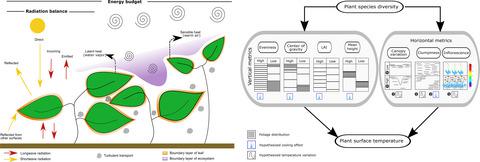Our official English website, www.x-mol.net, welcomes your feedback! (Note: you will need to create a separate account there.)
Biodiversity facets affect community surface temperature via 3D canopy structure in grassland communities
Journal of Ecology ( IF 5.5 ) Pub Date : 2021-02-20 , DOI: 10.1111/1365-2745.13631 Claudia Guimarães‐Steinicke 1 , Alexandra Weigelt 1, 2 , Raphaël Proulx 3 , Thomas Lanners 4 , Nico Eisenhauer 2, 5 , Joaquín Duque‐Lazo 6 , Björn Reu 7 , Christiane Roscher 2, 8 , Cameron Wagg 9, 10 , Nina Buchmann 11 , Christian Wirth 1, 2, 12
中文翻译:

生物多样性面通过3D冠层结构影响草原社区的地表温度
更新日期:2021-02-20
Journal of Ecology ( IF 5.5 ) Pub Date : 2021-02-20 , DOI: 10.1111/1365-2745.13631 Claudia Guimarães‐Steinicke 1 , Alexandra Weigelt 1, 2 , Raphaël Proulx 3 , Thomas Lanners 4 , Nico Eisenhauer 2, 5 , Joaquín Duque‐Lazo 6 , Björn Reu 7 , Christiane Roscher 2, 8 , Cameron Wagg 9, 10 , Nina Buchmann 11 , Christian Wirth 1, 2, 12
Affiliation

|
- Canopy structure is an important driver of the energy budget of grassland ecosystem and is, at the same time, altered by plant diversity. Diverse plant communities typically have taller and more densely packed canopies than less diverse communities. With this, they absorb more radiation, have a higher transpiring leaf surface and are better coupled to the atmosphere which leads to cooler canopy surfaces. However, whether plant diversity generally translates into a cooling potential remains unclear and lacks empirical evidence. Here, we assessed how functional identity, functional diversity and species richness of grassland communities in the Jena Experiment predict the mean and variation of plant surface temperature mediated via effects of canopy structure.
- Using terrestrial laser scanning, we estimated canopy structure describing metrics of vertical structure (mean height, LAI), the distribution (evenness) and the highest allocation (centre of gravity) of biomass along height strata. As metrics of horizontal structure, we considered community stand gaps, canopy surface variation and emergent flowers. We measured surface temperature with a thermal camera. We used SEM models to predict biodiversity effects on the surface temperature during two seasonal peaks of biomass.
- Before the first cut in May, herb‐dominated communities directly promoted lower leaf surface temperatures. However, communities with lower centre of gravity (mostly herb dominated) also increased canopy surface temperatures compared with grass‐dominated communities with higher biomass stored in the top canopy. Grass‐dominated communities showed a smaller variation of surface temperatures, which was also positively affected by species richness via an increase in mean height. In August, mean surface temperature decreased with increasing community CC and LAI. The variation of surface temperature was greater in herb‐dominated than in grass‐dominated communities and increased with plant species richness (direct effects).
- Synthesis. The mean and variation of canopy surface temperature were driven by differences in functional group composition (herbs‐ vs. grass dominance) and to a lesser extent by plant diversity. These effects were partly mediated the metrics of canopy structure but also by direct effects unrelated to the structural metrics considered.
中文翻译:

生物多样性面通过3D冠层结构影响草原社区的地表温度
- 冠层结构是草原生态系统能量收支的重要驱动力,同时,植物多样性也改变了冠层结构。与多样化程度较低的群落相比,多样化的植物群落通常具有更高,密度更高的树冠。这样,它们吸收更多的辐射,具有较高的透叶表面,并更好地与大气耦合,从而导致凉爽的树冠表面。但是,目前尚不清楚植物多样性是否通常会转化为降温潜力,并且缺乏经验证据。在这里,我们评估了耶拿实验中草地群落的功能特性,功能多样性和物种丰富度如何预测通过冠层结构影响介导的植物表面温度的平均值和变化。
- 使用陆地激光扫描,我们估计了冠层结构,该冠层结构描述了沿高度层的生物质的垂直结构(平均高度,LAI),分布(均匀性)和最高分配(重心)的度量。作为水平结构的指标,我们考虑了群落林分间隙,冠层表面变化和萌芽花。我们用热像仪测量了表面温度。我们使用SEM模型来预测生物量的两个季节性峰值期间生物多样性对地表温度的影响。
- 在5月的第一次割草之前,以草本植物为主的群落直接促进了较低的叶片表面温度。但是,重心较低的社区(主要是草本植物占主导)的冠层表面温度也比草质占主导地位的,顶部生物量较高的群落更高。以草为主的群落显示出较小的表面温度变化,这也受到平均高度增加而物种丰富度的积极影响。在八月,平均表面温度随着社区CC和LAI的增加而降低。以草为主的社区的表面温度变化大于以草为主的社区,并且随着植物种类的丰富而增加(直接影响)。
- 综合。冠层表面温度的平均值和变化是由官能团组成的差异(草药与草的优势)驱动的,而在较小程度上则受植物多样性的驱动。这些影响部分是通过调节冠层结构的指标来实现的,但也可以通过与所考虑的结构指标无关的直接效果来实现。


























 京公网安备 11010802027423号
京公网安备 11010802027423号